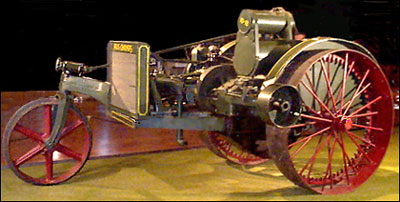
Allis-Chalmers Model 10-18 Tractor
Allis-Chalmers Manufacturing Co., Milwaukee, WI
Date: 1914 ID: 55.49.1
At the start of the twentieth century, American farmers relied on horses and steam for power on the farm. Though John Froelich first used a gasoline tractor on a South Dakota farm in 1892, farmers continued to till their fields with horses and used steam engines to thresh their oats and wheat. Like the automobile on the road, Americans hesitated to spend money on unproven internal combustion technology.
In the 1910s, countless companies built tractors or had machines in development. This included the Allis-Chalmers Company of Milwaukee, Wisconsin. The firm drew its origins from David Allis's steam engine company, which purchased William Chalmers' company in 1901 to create the firm of Allis-Chalmers. In 1914 the company introduced its first tractor model, the 10-18, and our tractor pictured above is part of that production run.
Like other steam engine manufacturers, Allis-Chalmers experimented with the new field of tractor design. Similar to some steam engines, the Allis-Chalmers 10-18 consisted of an engine mounted on a frame, but instead of a boiler to produce steam, it used a radiator to cool the engine. The tricycle style of the 10-18 allowed for a tighter turning radius, and the front wheel has a center ridge to improve its ability to turn. The tractor took its name for its rating of 10 horsepower (hp) off the rear drawbar and 18 hp off the flywheel. The Allis name is still available on tractors manufactured by the AGCO Corporation. http://www.agcocorp.com
Though farmers continued to use horses and steam power, manufactures designed new types of tractors. The Wallis Cub built by the J. I. Case Plow Works of Racine, Wisconsin in 1913 was the first to be built without a frame. Henry Ford began mass-producing tractors in 1917. In 1924, International Harvester marketed the Farmall Regular, a tractor that could work easily in row crops such as corn. In spite of these advances, a number of factors prevented tractors from overtaking horses. Many farms remained small in scale, and horses proved more economical than tractors. Many farmers who grew up with horses remained reluctant to make the switch to internal combustion. Not until 1954 did tractors become the preferred source of power on farms in the United States.
At Fall Harvest Days in Greenfield Village you can get up close to many kinds of farm power. Working steers from Greenfield Village and oxen from Tillers International of Kalamazoo show the role of cattle in American agriculture. The Percheron horses of Firestone Farm and the William Ford Barn in Greenfield Village will be hard at work in the fields, too. A 1917 Port Huron steam traction engine powers a Nichols & Shepherd threshing machine to separate oats and wheat from straw. Gasoline tractors demonstrate the emergence of gasoline tractors on American farms. Come see them all during our annual Fall Harvest Days. |

